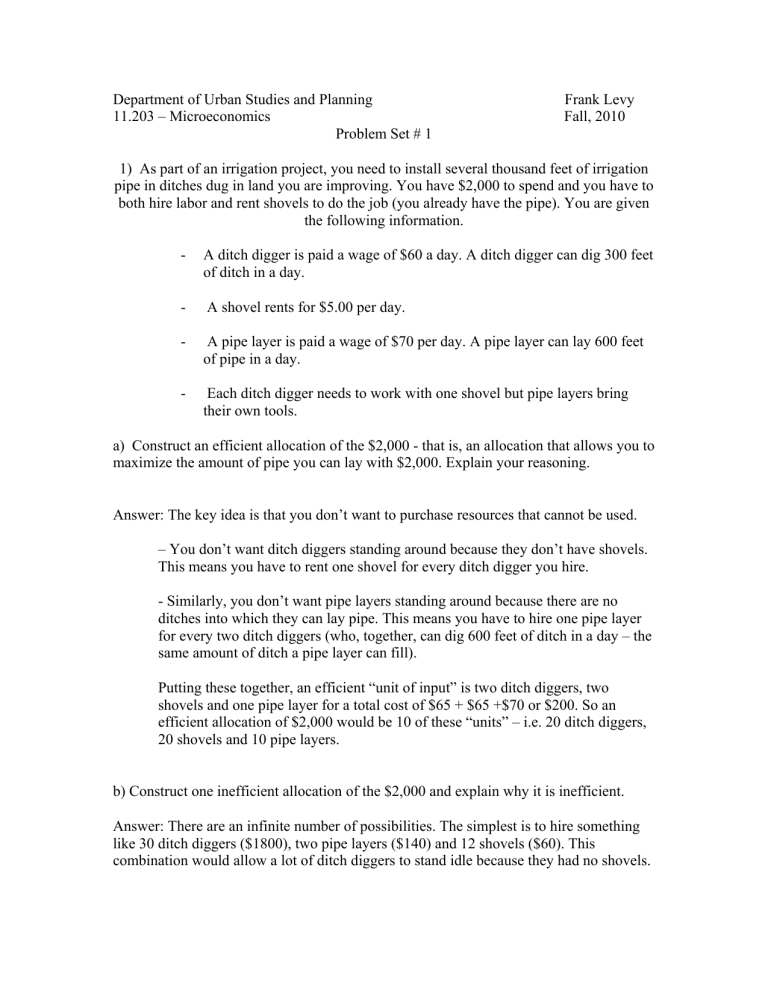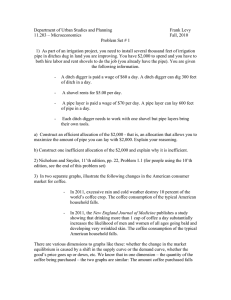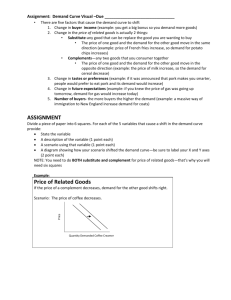Department of Urban Studies and Planning Frank Levy 11.203 – Microeconomics

Department of Urban Studies and Planning
11.203 – Microeconomics
Frank Levy
Fall, 2010
Problem Set # 1
1) As part of an irrigation project, you need to install several thousand feet of irrigation pipe in ditches dug in land you are improving. You have $2,000 to spend and you have to both hire labor and rent shovels to do the job (you already have the pipe). You are given the following information.
A ditch digger is paid a wage of $60 a day. A ditch digger can dig 300 feet of ditch in a day.
A shovel rents for $5.00 per day.
A pipe layer is paid a wage of $70 per day. A pipe layer can lay 600 feet of pipe in a day.
Each ditch digger needs to work with one shovel but pipe layers bring their own tools. a) Construct an efficient allocation of the $2,000 - that is, an allocation that allows you to maximize the amount of pipe you can lay with $2,000. Explain your reasoning.
Answer: The key idea is that you don’t want to purchase resources that cannot be used.
– You don’t want ditch diggers standing around because they don’t have shovels.
This means you have to rent one shovel for every ditch digger you hire.
- Similarly, you don’t want pipe layers standing around because there are no ditches into which they can lay pipe. This means you have to hire one pipe layer for every two ditch diggers (who, together, can dig 600 feet of ditch in a day – the same amount of ditch a pipe layer can fill).
Putting these together, an efficient “unit of input” is two ditch diggers, two shovels and one pipe layer for a total cost of $65 + $65 +$70 or $200. So an efficient allocation of $2,000 would be 10 of these “units” – i.e. 20 ditch diggers,
20 shovels and 10 pipe layers. b) Construct one inefficient allocation of the $2,000 and explain why it is inefficient.
Answer: There are an infinite number of possibilities. The simplest is to hire something like 30 ditch diggers ($1800), two pipe layers ($140) and 12 shovels ($60). This combination would allow a lot of ditch diggers to stand idle because they had no shovels.
2
It would also mean you ended up with empty ditch because there wouldn’t be enough pipe layers to fill the ditches dug by the 12 ditch diggers who could use the shovels.
2) Nicholson and Snyder, 11’th edition, pp. 22, Problem 1.1 (for people using the 10’th edition, see the end of this problem set)
3) In two separate graphs, illustrate the following changes in the American consumer market for coffee.
In 2011, excessive rain and cold weather destroy 10 percent of the world’s coffee crop. The coffee consumption of the typical American household falls.
In 2011, the New England Journal of Medicine publishes a study showing that drinking more than 1 cup of coffee a day substantially increases the likelihood of men and women of all ages going bald and developing very wrinkled skin. The coffee consumption of the typical
American household falls.
There are various dimensions to graphs like these: whether the change in the market equilibrium is caused by a shift in the supply curve or the demand curve, whether the good’s price goes up or down, etc. We know that in one dimension – the quantity of the coffee being purchased – the two graphs are similar: The amount coffee purchased falls in both cases. Briefly explain how and why the graphs differ or are similar in their other dimensions.
Bad Weather Medical Journal Article
$/pound of coffee
$/pound of coffee
# of pounds of coffee # of pounds of coffee
3
Answer: This case is similar to the class example describing different reasons for the declining proportion of women who are secretaries. The rain-cold weather story is an argument about the supply curve – in particular, the supply curve shifting inward which leads to lower purchases and higher prices (i.e. the high prices choke off demand). The medical journal article argument is an argument about the demand curve – the demand curve shifting inward because people want to avoid coffee’s newly discovered side effects. This also leads to lower purchases but lower prices rather than higher prices.
4) The readings for this week include a New York Times story for August 5, 2010 describing an emergency order barring wheat exports from Russia. Read the article and then use appropriate supply and demand diagrams to illustrate the positions of the
Russian and U.S. wheat industries for each of the following dates:
- August 1, 2009 (i.e. roughly one year before the announcement)
- August 1, 2010 (four days before the announcement)
Russia United States
$/bushel
$/bushel
2010
2009 2009
2010
# of bushels # of bushels
Answer: A basic answer says that In Russia, the demand curve for wheat remains constant but the fires and drought have contracted supply leading to higher prices.
In the U.S. the supply curve for wheat has remained constant but demand (including demand for exports) has increased because of increased foreign demand due to the
Russian shortages and so the demand curve has shifted out leading to higher prices.
4
5) In the basic supply-demand graphs we use in class, we describe show the market reaching an equilibrium price in which the quantity supplied equals the quantity demanded.
As the graph below shows, in July 2005 when the economy was fairly strong, there was a roughly constant inventory of about 2.5 million unsold homes throughout the year.
Today, there is an inventory of about 4.7 million unsold homes.
Image courtesy of Bill McBride. Used with permission.
Do these inventories, even in a good year, mean the market for single family homes is always in crisis? Do they mean the single family homes market is in crisis today? Give a brief explanation of what you think was going on in the market in 2005 and what you think is going on today. If it is useful, illustrate your answer with appropriate diagrams.
Answer: The answer to this question involves common sense and the ways in which the graphs we use simplify reality. Common sense tells you that even in good housing markets, at any moment in time, there will be some unsold houses available on the market. (I don’t want to get off on a tangent but the reason there are always some unsold houses begins with the fact that houses differ from each other in various ways including location so sellers take time to learn how much they can sell their house for and buyers take time to learn all the houses that are available and what they cost. If housing market were like the market for soft white wheat – one homogeneous product, a single price on any day, etc., the inventory of unsold houses could be much smaller.)
5
In this case, our notion of supply-demand equilibrium means that the number of new houses that come onto the market in any month and enter the pool of available homes should roughly equal the number of houses that are purchased from the pool of available homes. In other words, the number of unsold houses on the market should remain roughly constant (as it did from January 2002 through January 2005).
When the number of unsold homes starts rising sharply, as it did after January 2005, that means that the number of people wanting to sell homes is significantly larger than the number of people wanting to buy homes. It is that imbalance that reflects the crisis.
6) The readings for Tuesday, September 14, include a New York Times story on a proposal by the U.S. postal service to increase the fee for a first class stamp. Read the story and answer the following questions: a) Below are four possible estimates of the price elasticity of demand for first class mail service. Given the post office’s rate proposal, explain which of the estimated elasticities they think must be correct. If the rate proposal is consistent with more than one estimated elasticity, explain why.
ε = + .1
ε = + 1.3
ε = -.2
ε = -1.2
Answer: The answer is -.2. That is, the Post Office is betting that the demand curve, while downward sloping, is inelastic so that the higher stamp price will bring in more revenue.
If the Post Office believed the elasticity was -1.2, it would mean that a higher stamp price would bring in less revenue and so they wouldn’t be considering the proposal.
The positive price elasticities of .1 and 1.3 would describe demand curves in which a higher price increased demand for stamps (i.e. not just increased revenue but increased the number of stamps purchased). Technically, these demand curves would be consistent with their proposal but they are too unrealistic to take seriously
One other point to note here: In real world situations like this one, the Post Office may not know the exact shape of its demand curve and so it is determining elasticity of demand through trial and error. In other words, it is forced to make a risky decision.
When we draw a demand curve and act as if we know its shape, we are ignoring the risk that is a big part of business pricing decisions. b) Looking back over the last two decades, how, if at all, would you have expected the growth of email to affect the demand curve for first class mail? In your answer, consider both shifts in the curve and changes in elasticity. Would you expect the development of
6 instant messaging and Twitter to have similar effects on the demand for first class mail?
Explain why or why not.
Answer: Email substitutes for certain kinds of letters. Other things equal, this should cause the demand curve for first class mail to shift in and to be more elastic (because there are more substitutes) than it otherwise would have been (i.e. we would expect the demand curve for first class mail to be changing over two decades in any case and so we are asking what email would do vis-à-vis the changes without email.
Instant messaging and Twitter should have smaller effects because they convey messages that are very short and time sensitive and so these messages probably would not have made it into a first class letter in any case.
Note for Problem 2: Problem 1.1 in NS 11’th edition begins with the same data as
Problem 1.2 in the 10’th edition but substitute the following questions: a. Graph the points of these supply and demand curves for orange juice. Be sure to put price on the vertical axis and quantity on the horizontal axis.
Milk
2
1
0
0
7
6
5
4
3
Supply
Demand
200 400 600 800 1000 1200
Quantity (millions of gallons) b. Do these points seem to lie along two straight lines? If so, figure out the precise algebraic equation of these lines. (Hint: If the points do lie on straight lines, you need only consider two points on each of them to calculate the lines.)
Answer: Yes, they lie along two straight lines:
Q
D
= 800 – 100P Q
S
= -100 + 200P c. Use your solutions from part b to calculate the “excess demand” for orange juice if the market price is zero.
Answer: 800 million gallons
7
Excess demand = Q
D
– Q
S
at P= $0. Note that although Q
S
appears to be -100 million gallons at P= $0, this is effectively 0, since suppliers can’t sell negative gallons of milk. d. Use your solutions from part b to calculate the “excess supply” of orange juice if the orange juice price is $6.00 per gallon.
Answer: 900 million gallons
Excess demand = Q
S
– Q
D
at P= $0.
***********************
MIT OpenCourseWare http://ocw.mit.edu
11.203 Microeconomics
Fall 2010
For information about citing these materials or our Terms of Use, visit: http://ocw.mit.edu/terms .





